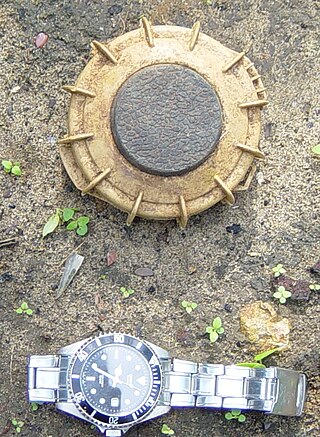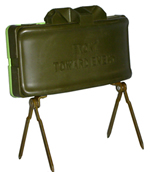The MAPED F1 is a claymore-shaped plastic-bodied directional anti-personnel mine which is designed to wound or kill by fragmentation. It has been the standard directional anti-personnel mine of the French army since the late 1970s.
The MAPED F1 body is flat on the back and convex on the front, it has a small aiming sight on the top left corner and plastic lugs in the bottom corners for attaching a pair of "A" frame support legs. The mine contains a plastic explosive charge to propel 500 steel ball fragments to a range of 50 meters in a 60° arc. The MAPED F1 is battery powered and is normally actuated by breakwire, but tripwire and command actuation are also possible.
The MAPED F1 is surface mounted and it can be located visually or with metal detectors under most field conditions. The MAPED F1 can be defeated by blast overpressure from explosive breaching systems like the Giant Viper and MICLIC unless it is set up for command actuation.
The MAPED F1 uses a very complex electric firing system. It is basically actuated by a contact wire. The battery pack and firing cable are attached to an electric detonator which is inserted in the mine and a spool of contact wire is rolled out. Any contact with the wire after the MAPED F1 is armed will break the fibre, which collapses an electrical circuit and triggers the mine.
The MAPED F1 is surface mounted. On detonation the mine will normally propel lethal fragmentation to a range between 40 and 60 meters. The actual hazard range for these types of mines can be as high as 300 metres based on US Army tests of the M18A1 "Claymore" (this is directly in front of the mine; fragmentation range and density drop off to 125 meters to the sides and rear of these mines).

The Claymore mine is a directional anti-personnel mine developed for the United States Armed Forces. Its inventor, Norman MacLeod, named the mine after a large medieval Scottish sword. Unlike a conventional land mine, the Claymore is command-detonated and directional, meaning it is fired by remote-control and shoots a wide pattern of metal balls into the kill zone. The Claymore can also be victim-activated by booby-trapping it with a tripwire firing system for use in area denial operations.
The GATOR mine system is a United States military system of air-dropped anti-tank and anti-personnel mines developed in the 1980s to be compatible with existing cluster dispensers. It is used with two dispenser systems—the Navy 230 kg (500 lb) CBU-78/B and the Air Force 450 kg (1,000 lb) CBU-89/B. Additionally the mines are used with the land- and helicopter-based Volcano mine system.

Valmara 69 or V-69 is an Italian bounding anti-personnel mine manufactured by Valsella. The mine was developed from the V-59 mine, and although the mine is no longer produced in Italy, a number of copies were produced in other countries e.g. the "SPM-1" manufactured by Singapore.

A nail gun, nailgun or nailer is a form of hammer used to drive nails into wood or other materials. It is usually driven by compressed air (pneumatic), electromagnetism, highly flammable gases such as butane or propane, or, for powder-actuated tools, a small explosive charge. Nail guns have in many ways replaced hammers as tools of choice among builders.

The MON-50 is a Soviet rectangular, slightly concave, plastic bodied, directional type of anti-personnel mine designed to wound or kill by explosive fragmentation. It first entered service in 1965 and is a copy of the American M18 Claymore with a few differences. Its name is derived from Russian мина осколочная направленного, "directional fragmentation mine".

The MRUD is a Yugoslav design of plastic bodied, convex rectangular directional type anti-personnel mine designed to wound or kill by fragmentation. It is broadly similar to the M18A1 Claymore mine.

The MON-90 is a Claymore-shaped, plastic bodied, directional type of anti-personnel mine designed in the Soviet Union. It is designed to wound or kill by fragmentation. The mine is similar in appearance to the MON-50, but is approximately twice the size with a much greater depth.

The MON-100 is a circular, sheet metal bodied, directional type of anti-personnel mine designed and manufactured in the early 1960s by the Soviet Union. It is designed to wound or kill by fragmentation and resembles a large bowl.

The M86 Pursuit Deterrent Munition (PDM) is a small United States anti-personnel mine intended to be used by special forces to deter pursuing enemy forces.

Anti-personnel landmines (APLs) are a form of mine designed for use against humans, as opposed to anti-tank mines, which are designed for use against vehicles. Anti-personnel mines are classified into blast mines and fragmentation mines; the latter may or may not be a bounding mine.
The POMZ, POMZ-2 and POMZ-2M are three types of Soviet-made stake mounted anti-personnel fragmentation mine. The POMZ mine was used during the Second World War. It was superseded by the POMZ-2, and later by the improved POMZ-2M. These mines have been used in numerous conflicts, including the Vietnam War and the Korean War.
The NR-413 is a Belgian trip wire activated anti-personnel stake mine. The main body of the mine is wine bottle shaped, with an NR 410 tripwire fuse screwed into a fuse well on the top of the mine. Under the fuse well is a detonator and a row of booster pellets. Wrapped around the detonator and booster pellets is the main charge. An internally square cross-sectioned steel wire is coiled around the outside of the mine, which give a fragmentation effect. The mine produces 600 fragments with a velocity of approximately 1,660 metres per second. It has an effective range of around 15 metres. A variant is produced with a cast steel fragmentation jacket.
The MBV-78-A2 is a small cylindrical Vietnamese anti-personnel fragmentation stake mine. It is unrelated to the MBV-78-A1. The mine has a large plastic head which contains the main charge wrapped around the detonator. A fragmentation layer of steel pieces set into wax surrounds the main charge. The plastic head has two mounting lugs for stake mounting the mine. A Vietnamese copy of the Russian MUV fuze is typically used with the mine, although other fuzes could be used.
The Model 123 is a small Thai Claymore style directional anti-personnel mine. The mine has a square plastic main body with a convex front face marked with a triangle which is supported by two sets of scissor legs. Inside the main body is a layer of four hundred 5.5 millimeter steel ball bearings embedded in an RDX type explosive. The mine is normally used with an electrical detonator which is inserted into the top of the mine.
The Mini MS-803 is a small South African produced Claymore type landmine. The design is very simple, with a convex brown polystyrene case containing a PE9 plastic explosive charge with three hundred 6 x 8 millimeter cylindrical steel fragments embedded into it. The mine is supported by two pairs of wire legs, which can be used to stack the mines. On the top of the mine is a small hole for inserting a detonator, which is surrounded with a PETN booster charge. The mine is normally used with an S4 electrical detonator connected to an M57 electrical firing device which is also used with the similar but larger Shrapnel mine Mk 2. The mine could also be used with MUV type pull detonators and tripwires, but after the Ottawa mine ban treaty South Africa has said that it will not use this mine with victim activated fuses.
The HAMDY mine is an Egyptian directional fragmentation mine based on the US Claymore mine and produced by the Maasara Company. The mine consists of a rectangular sand colored plastic main body with a convex face, inside which is a layer of approximately 700 steel fragments embedded in a main charge of cast explosive. The mine is supported by two sets of scissor type legs. On the top of the mine is a crude peep sight and two detonator wells, designed to accept electrical command detonators or MUV style trip fuzes. When triggered the mine scatters fragments in an arc of 60 degrees to a range of 50 meters and a height of approximately two meters.
The Cardoen EC-2 mine is a Chilean directional fragmentation anti-personnel mine. It is broadly similar to the United States M18 Claymore mine.
The MMN-1 is a small Georgian Claymore type directional anti-personnel fragmentation mine. The mine projects fragments in a sixty degree horizontal arc to a casualty radius of 15 meters.
The MMN-2 is a Georgian Claymore type directional anti-personnel fragmentation mine. The mine projects fragments in a forty-five degree horizontal arc to a casualty radius of forty meters.

The M5 modular crowd control munition (MCCM) is a non-lethal direct fire device used to disperse, incapacitate and deny area access to large groups of people with percussion and flash (flash-bang) along with the impact from 600 high-velocity rubber or plastic balls moving outwards towards the crowd. It can be deployed and set up by troops and detonated via a command wire.